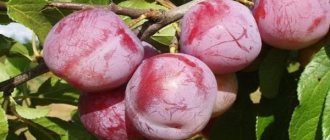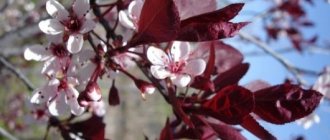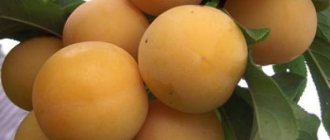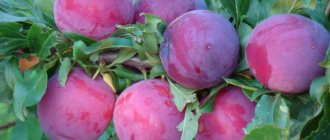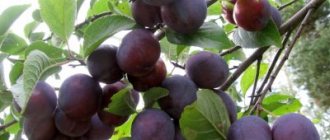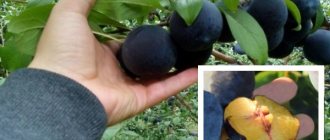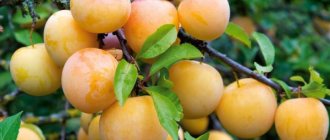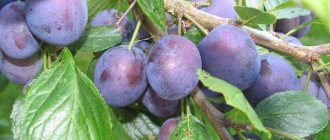The blackthorn is the result of crossing a sloe and a domestic plum. This subspecies is known for its high productivity, unpretentiousness and frost resistance. Therefore, it is especially valued in the gardens of the northern part of the country, where not every fruit tree can grow. In addition, the plant has a lot of beneficial properties for the body and is an excellent product for preparing winter preparations.
History of creation
Sloes and Plum Domestica in the biological classification belong to the same genus - Plum (Pink family). Damson is the result of natural hybridization of these plants. The subspecies was obtained through cross-pollination of crops in natural conditions. Today there are several varieties of this subspecies that are actively cultivated in home gardens.
Some scientists believe that damson is a hybrid of sloe and cherry plum.
Many sources indicate that the plant was first grown in South-West Asia, near the territory of the modern capital of Syria. There they called it “Damascus Plum”. Subsequently, the culture was brought to England, and from there it spread throughout Europe and came to Russia.
Ternosliv took the best qualities from its “parents”. It tolerates drought well and is not as capricious as ordinary plum trees. Its fruits are sweet and tart and contain many useful substances. Thanks to its frost resistance, it can be cultivated in almost any part of Russia, including the northern regions.
Differences between sloe and damson
Thorn is a shrub with healthy but tasteless fruits. Thanks to crossing with plum, the value of its tart fruits was “flavored” with plum sweetness. At the same time, almost all the beneficial qualities of the thorn fruit were “inherited” by the damson plum.
In contrast to sloe, damson fruits are much larger, sweeter and juicier, and most importantly, they are not so tart. Blackthorn is not as prickly as blackthorn - the fruits from it are much easier to collect. Sloe fruits and damsons have a similar chemical composition. The only major difference is the sugar content:
Main characteristics
The damson is a shrub or medium-sized tree that can grow up to 5 m in height. Most often it is grown as a tree rather than a multi-stemmed shrub. It grows quickly and over time actively produces root shoots, which are most often used to prepare planting material.
The branches are spreading, well developed, covered with sharp spines (not as significant as those of the thorn). The leaves are small (up to 4 cm), ellipsoidal, dark green, leathery. There are teeth along the edges.
Flowering begins in April-May before foliage appears. The flowers are mostly solitary, sometimes forming a pair. The flowers are small in diameter (1.5-2 cm), grow on short peduncles, are white, and densely cover all branches. They have a pleasant aroma that attracts the attention of pollinating insects.
The fruits begin to ripen from the end of July, and are fully ripened by the end of August - beginning of September. At the same time, they can hang on the branches for a long time - right up to winter.
There are often so many fruits that it is necessary to put supports under the branches so that they do not break under the weight of the fruit.
Ternosliv has excellent frost resistance. It can withstand frosts down to -37C and survive in very harsh climatic conditions. In addition, it tolerates drought well and is able to actively bear fruit even without regular watering.
Plum splayed
The spreading plum belongs to the category of red-leaved trees of tall and medium height with abundant and rapid fruiting - the first harvests are harvested from it already 2 years after planting. As a rule, plum varieties are intended for growing in warm climates.
Hesey
A bush variety of red-leaved plum called Hesei produces regular green foliage at first - but then the leaves turn purple, with pink or cream edges. The variety blooms with white flowers at the end of April, before the leaves bloom or simultaneously with it. Bears sweet and sour small red fruits.
The variety is characterized by low frost resistance and tolerates negative temperatures only up to – 28 degrees. Among the diseases that remain dangerous for him are black or holey spots. To obtain fruits, it is necessary to plant splayed plums with similar flowering periods nearby.
Pissardi
An Iranian plum variety up to 6 m tall with dark purple leaves and red shoots. Pissardi is an ornamental plum with pink flowers that blooms in early spring before the leaves bloom. In August it produces abundant pink fruits, provided that other varieties of spreading red-leaved plum have been planted nearby for pollination and bloom at the end of April.
The frost resistance of the Pissardi variety is not very high - from -20 to -28 degrees. But the tree is highly resistant to disease.
Cystene
This ornamental variety was obtained by breeding sand cherry and red-leaved Pissardi plum. The dwarf plant grows only up to 2 m, and at the same time it grows very slowly, so Cysten plum is often classified as a shrub with a columnar crown. The leaves are elongated, rounded and toothed, dark purple on the underside and red-violet on top.
The red-leaved Cystena blooms in early spring with white flowers with a red core, and in late summer it bears fruit - dark purple small drupes. If you plant other varieties of short red-leaved plums nearby, Cystena will delight you with abundant harvests.
The frost resistance of the variety is low, so it is not recommended to breed Cystena in cold regions. But the variety is quite resistant to diseases and pests.
Description of fruits
The fruits of damsons are drupes. They are significantly larger than the sloe, but are also very useful. They contain many nutrients, such as pectin and tannins, minerals and vitamins, flavonoids and amino acids. They have antiseptic, astringent and diuretic effects. The drupes of this plant are often recommended for use by people with diseases of the gastrointestinal tract, kidneys and liver.
The drupes grow spherical or oval in shape, blue-violet or black-blue in color with a waxy coating that is easily removed. The average weight of the fruit is 10-12 g (rarely exceeds 15 g). The pulp is greenish, dense, astringent, sour, slightly sweet (sweeter than sloe). The composition contains 10% sugars and 12% organic acids, which provide a sweet and sour taste.
A distinctive feature of damson fruits is astringency. When the first frost touches them, the astringency softens a little.
Drupes can be eaten fresh or made into preparations (jams or compotes). Also very popular is prune wine, which has an unusual, pleasant, subtle taste.
Nutritional and medicinal properties of the culture
The fruits of damsons contain up to 10% sugars, about 12% organic acids, as well as biologically active pectin and mineral substances necessary for a full human life.
As for canning qualities, pectins, tannins, and coloring substances of a polyphenolic nature, which have P-vitamin activity and impart an astringent taste to the fruits, play an important role.
The fruits themselves and their processed products are often used for medicinal and preventive purposes, especially to improve the normal functioning of the stomach and intestines (especially with low acidity). Damon fruits and their processed products are contraindicated for people suffering from heartburn or increased acidity of gastric juice.
Types of varieties
Initially, damsons were obtained through natural selection. When scientists appreciated its properties, various research institutes began to work on obtaining new varieties. Here are the most popular ones:
- Pride of Siberia . Excellent for growing in continental and sharply continental climates. The tree is not tall. The drupes are large (up to 25 g) and relatively sweet. In summer they are bright ruby in color, and by autumn they turn dark blue.
- Bilasuvar . The culture was bred in the subtropical climate of Azerbaijan, however, it shows good results in the northern regions. It is a shrub whose shoots can reach 3 m. The ripening period is late: late September - early October. The taste is sweet and sour with a pleasant tartness.
- Garden No. 2 . Zoned for the Central Black Earth region. It is distinguished by high taste, large-fruited and abundant harvest (on average 20-30 kg per tree).
- Apricot . A hybrid form for which the Asian black apricot was used. The result was a crop with slightly pubescent, sweet and sour purple drupes with a pleasant apricot aroma. The fruits acquire a more pleasant taste after several days of storage.
- Fragrant 83 . Also a hybrid with American plum. The result is a tree whose fruits are characterized by medium ripening, large fruit, pleasant aroma and lack of astringency.
- Large-fruited . The tree can grow up to 3-4 m. The ripening period is late. The drupes are round, slightly elongated, purple in color with a waxy covering. The taste is sweet and sour, with a slight pleasant astringency.
- Large-fruited early . The tree is not tall - up to 2.5 m. The harvest ripens in August, its volume is not too large - about 12 kg. The drupes are small, dark purple, slightly tart.
Pride of Siberia
Bilasuvar
Apricot
Ternosliv - the daughter of domestic plum and sloe
In recent years, interest among amateur gardeners has sharply increased in such a rather rare crop as damson, the fruits of which, however, are widely used for canning. Damon trees, when compared with plum varieties, are much less capricious and more resistant to unfavorable climatic conditions, which contributes to their reliable and stable yield, even in the harsh northern and no less harsh eastern regions of the non-chernozem zone. In addition, damsons begin to bear fruit much earlier (already in the 2nd year, and not in the fifth or even seventh, like plums) and can produce significant yields, often exceeding 30 kg of fruit per tree.
Diseases and pests
Most often, diseases and pests of various kinds do not harm this plant. However, in rare cases, the development of clasterosporiasis, a common fungal disease of stone fruit crops, can be noted. First, it affects the leaves, causing them to fall prematurely, and then the fruits.
To treat clasterosporiasis and other diseases (pockets, fruit rot, smallpox, etc.), industrially produced drugs – fungicides – are used. It is necessary to start fighting the disease at its first signs, otherwise it will progress and be able to infect other crops.
Among the pests, the ringed silkworm, which lives in the Volga, North Caucasus and Far Eastern regions, most often attacks damson plums. The caterpillars of this butterfly feed on leaves and can damage a significant number of them. To combat the pest, insecticides are used, and branches with silkworm ovipositors must be cut and burned.
Biological description of the thorn bush
Thorn (thorn) is a branching prickly shrub, reaching a height of 3.5 to 4.5 m. Less commonly, the plant can be found in the form of a tree up to 8 m in height.
A distinctive feature of the shrub is its high root-forming ability. After several years of development, impenetrable thickets are formed from numerous root shoots.
The natural habitat of the bush is hillsides, ravines and forest edges of Central Asia, the Caucasus, the Mediterranean, Western Siberia and Europe.
It is assumed that the sloe evolved from the cherry plum as a result of modification of the tissues of the bush under the influence of gradual changes in the microclimate.
Sloes are highly frost-resistant and can withstand low temperatures down to 40 °C. The shrub can survive drought without much stress.
Thorn develops well on the soils of the Moscow region, which are not suitable for growing other crops, so it is often placed on the borders of a personal plot where the soil is salinized.
The young branches of the bush are covered with pubescent bark and form sharp spines at the end. The leathery leaves are obovate, toothed and dark green in color. They are located on short petioles and reach a length of up to 5 cm.
Before the leaves bloom, the thorn blooms profusely in April and May. The flowers of the plant are small and white
Before the leaves bloom, the thorn blooms profusely in April and May. The flowers of the plant are small, white and arranged in pairs or singly on short peduncles.
During this period, the bush looks like a large white ball, and the area around it is filled with the aroma of almonds.
The shrub begins to bear fruit 2-3 years after planting. The fruit is single-druped, round in shape and small in size, up to 15 mm in diameter.
Under the thin black-blue peel lies green pulp and an inseparable seed. The fruits ripen at the end of summer and can last on the bush all winter.
The fruits of the bush have a tart-sour taste: this is due to the high content of tannins, which are neutralized after exposure to low temperatures.
Therefore, many gardeners prefer to harvest not immediately after the fruits ripen, but after the first frost.
Fruiting is regular, 3-4 kg of fruit can be collected from one bush.
The sloe is a self-sterile plant and is not capable of setting fruit from its own pollen. To ripen the fruits, the plant requires cross-pollination. It is mainly produced by bees.
To ripen the fruits of the Thorn plum, cross-pollination is required.
The shrub propagates by seeds, dividing the bush and root cuttings. It is preferable to sow seeds in the fall immediately after separation from the pulp.
For spring sowing, proper long-term stratification will be required on average 160 days. To do this, the pit is washed from the pulp, placed in layers of moss and put in a cold place with a temperature of 0°C to 5°C.
A month before planting, the temperature is reduced to -1°C. The seeds are kept in a slightly moist environment.
The readiness of the seed for transplanting into the substrate can be judged by the cracks on the surface. For temporary development, you will need a container of at least 20-25 cm in diameter.
The optimal substrate for the development of damson seedlings consists of:
- turf soil 40%;
- humus 20%;
- lowland peat 20%;
- river sand 20%.
Further care of the seedling consists of regular watering and fertilizing once a month with minerals.
Seedlings are transplanted to a permanent location at the age of two. Sloes grown from seed will bear fruit 4-5 years after planting.
Many gardeners prefer the method of propagation by seeds to obtain frost-resistant rootstocks for more capricious crops.
The plum variety Thorn reproduces well by dividing the rhizome, seeds and root cuttings
Young shoots are separated from the mother plant in the fall; for this, the connecting root is cut. At the end of April, the separated shrub is transplanted to the intended site.
The plum variety Thorn (thorn) reproduces well by dividing the rhizome. To do this, you need to dig up the roots in the fall at a distance of 1 to 1.5 m from the trunk. A good planting material is a root with an average thickness of 1.5 cm and a length of 15 cm.
Until spring, the roots are stored in layers of damp sawdust or moss in a cool room, ideally a basement.
At the end of April, the cuttings are transplanted into soil (sand, peat 1:3) under a film. They are placed at a distance of 5 cm vertically at a slight angle.
The upper ends should remain at a depth of 2 cm, after which the surface of the soil is mulched with sawdust. Root cuttings need to be provided with regular watering and 3-4 feedings per season, mainly with nitrogen fertilizers.
Next autumn, the plant is transplanted into temporary soil, similar to when planting seeds, and grown to 1 m, after which it is transplanted into a personal plot.
A characteristic feature of the sloe is its absolute unpretentiousness to growing conditions. On the contrary, excessive care and constant feeding of the bush lead to abundant growth and suppression of neighboring plants.
This can be avoided if, during planting, the roots of the thorn are protected from spreading horizontally with a sheet of slate or iron.
For planting thorns, a well-lit or semi-shaded area is preferable. The soil should be drained, moisture-absorbing and neutral acidity. The optimal distance between bushes is at least 2 m.
In March, rejuvenating pruning is carried out, removing damaged and rotten branches. Ideally, there will be 3-4 skeletal branches left on the bush.
This will significantly increase the quality and quantity of the harvest and protect the bush from severe thickening of the crown.
We invite you to read: Breeding pheasants as a business. Pheasant farm plan for maintenance and cultivation
Water the sloe only in very dry weather. To improve the quality of fruits and the formation of new shoots during flowering, organic matter is added to the tree trunk circle: compost or rotted manure. The blackthorn does not require winter shelter.
The thorn plant is a tall shrub, the height of which reaches 3 – 5 meters. Some of its species are low trees up to 5 meters high. The branches grow in a horizontal direction. They are covered with numerous sharp and thick spines.
The shape of the matte, dark green leaves of the plant is obovate or elliptical, with a serrated edge. The leaves are about 5 centimeters long.
The blackthorn plum is very beautiful during flowering, when the bush is covered with a cap of white flowers even before the leaves appear. They emit a bitter almond aroma and attract many bees to collect their nectar and pollen. Therefore, the plant is considered honey-bearing. The start time of flowering depends on the area where the sloe grows. The shrub may bloom in April or May.
Blackthorn wood is very strong and hard, and has a reddish-brown hue. It is used for the manufacture of small turning and carpentry products. The roots of the plant go 1 meter deep into the soil and are densely branched, so that they extend far beyond the crown projection.
Thorn is a winter-hardy and drought-resistant shrub. Gardeners speak of it as an unpretentious plant that is easy to care for. It is often used as a rootstock for plums and apricots, planted on crumbling slopes to strengthen the soil, and also to create hedges of thorns. To decorate the garden, it is recommended to plant terry, red-leaved, and purple varieties of blackthorn.
The ripening period for damson plums is from July to August. One fruiting bush can produce up to 15 kilograms of berries, which are well preserved during transportation and have a shelf life.
But you can start harvesting thorns only after the first frost has occurred; until this time, damson plums are inedible. It is worth choosing elastic, strong berries, without inclusions of rot, cracks and sores. Damaged fruits are unsuitable for processing.
To ensure that the benefits of damson plums last for a long time, they can be subjected to minimal heat treatment. Store berries frozen or dried. In this form, their healing properties remain unchanged throughout the year. Fresh fruits must be consumed within 10 days.
Prickly, inconspicuous-looking thorn bushes are actually a source of healthy fruits. Skilled housewives prepare healing decoctions, sweet preparations and sauces for various dishes from them. Blackthorn fruits will appeal to those who know how to properly collect and store them. And decorative thorn hedges delight the eye from the beginning of spring until late autumn.
The pulp is yellow, sweet and sour, without astringency, with a subtle aroma of apricot and strawberry. The bone is small and difficult to separate.
The most delicious variety of damson plums, Shropshire Prune, comes from England. The ripe fruits are honey-sweet without astringency. Quite widespread varieties are: Demson Big Mekki, Ternosliv Lozovatsky, Ternosliv Volzhskaya, Tenkovskaya blue, etc. There are decorative forms of thorns with a weeping and pyramidal crown, with bright pink flowers and red-leaved ones.
Growing sloe and damson plums is slightly different from domestic plums. The main differences are as follows.
The distance between plants in the garden is 3-4 m.
The crown is formed as a bush, fan, half-trunk, spindle or pyramid.
When planting in holes with a depth and diameter of 70 cm, only 1-2 buckets of compost are added; mineral fertilizers are not needed. Both sloe and damson grow quickly when young. Long vertical growths refuse to bear fruit, and with strong shortening, shoot growth is even more activated. Accordingly, young trees are not fed.
Blackthorns, like Cinderellas, eat little and work a lot, but care is still needed to obtain guaranteed yields. Deep loosening in the projection of the crown and damage to large roots should be avoided, otherwise both the tree and the gardener will suffer - a lot of shoots will appear. Thorn and Damon plums are not susceptible to most stone fruit diseases, which cause great damage to plums.
Sloes are propagated by seeds, as well as root suckers, green cuttings and grafting. Seeds are sown in the fall, immediately after separation from the pulp, or in the spring, after pre-sowing stratification. Two-year-old seedlings are planted in a permanent place in spring or autumn. The fruits are harvested when fully ripe in August - September.
Collection and preparation
Advantages and disadvantages
Damson plum is one of the most beloved crops of Siberia and the Far East. It is also grown in other regions because it has the following positive qualities:
- frost resistance;
- good immunity;
- early dates of fruiting;
- small tree size with abundant yield;
- The fruits contain many useful substances.
Disadvantages include taste, which may not be to everyone’s taste. The excessive astringency and acidity of drupes is not to everyone’s taste.
Advantages and disadvantages
A hybrid of blackthorn and plum has a number of advantages:
- frost resistant;
- excellent yield;
- the fruits remain excellent on the branches until frost;
- excellent raw materials for medicines;
- easy to care for;
- tolerates transportation well;
- has stable immunity to diseases;
- Great for winter preparations, culinary products, making wine;
- has a good vitamin composition.
Disadvantages include slight astringency, viscosity of taste and fruit size.
If earlier this shrub was successfully grown everywhere, today it is undeservedly preferred to other varieties of plums.
Growing damsons, which can be called the pride of breeders, is profitable as an excellent business. On an industrial scale, damsons are used to make vinegar and liqueurs.
Landing
It is best to plant in early spring, although autumn is also suitable for work. You can choose any place for the seedling, but experienced gardeners recommend planting at the border of the site. In this way, you can create a natural windbreak for other plants.
The damson produces a lot of root growth, which must be removed regularly.
It is recommended to prepare the planting hole in the fall or 2-3 weeks before the actual work. The hole is dug to a depth of about 40-50 cm and filled with a nutrient mixture:
- a bucket of humus or compost;
- a glass of wood ash;
- 2 tablespoons lime.
Before planting, the roots of the seedling are dipped in a biogrowth stimulator or clay-manure mash. Pour some warm water into the hole and place the seedling there. Dig in well and water.
Features of agricultural technology
Planting and caring for the damson varieties considered should not be difficult even for not very experienced gardeners. The basic principles of cultivation are not much different from the rules for caring for garden plums, only expressed in a simplified form:
- Selection of planting material. Growing a tree can be started from a seedling, a seed, or by grafting onto a regular plum tree. The simplest and most effective way to plant damsons is, of course, to plant a ready-made seedling. When choosing a sprout, preference should be given to a two-year-old plant with a well-developed root system.
- Choosing a landing site. The damson plum is not at all picky about the soil; it only tolerates swampy and overly salty soils. But if possible, it is better to choose soil with low acidity or adjust it by adding lime. Another nuance is that planting should be planned with a diameter of 4-5 m per tree.
- Planting damsons. Planting is recommended in the spring. A hole is dug, 50 cm deep and 70 cm in diameter. You can lay drainage at the bottom using crushed stone and sand. Mix the soil with manure and ash. The seedling is placed in the hole, the roots are carefully straightened and covered with prepared soil. After planting, the root collar should protrude 2-3 cm above the ground level. The tree is watered abundantly, and mulching can be done.
- Fertilization and care of damsons. The young damson tree grows rapidly and additional fertilizer is not recommended. During this period, before fruiting begins, it is enough to loosen the soil and, if necessary, water. Trimming should also be done shallow, gradually forming the crown. Already 3-4 years after planting, with the beginning of fruiting, you can apply organic fertilizers or mineral complexes in spring and autumn. At this time, more serious pruning should be carried out, removing young pagons and forming a crown with 4-5 main branches.
The damson is resistant to diseases and pests, but can sometimes be affected by fruit rot, damson, and dwarfism. In such cases, the wood is treated with special means.
Care
The plant is completely unpretentious in care. It is enough to perform the simplest manipulations to increase the quality and quantity of the future harvest.
Watering
The culture is drought-resistant, so it does not require frequent watering. Water is added as needed (when the tree trunk circle dries out), using no more than 2 buckets of water. Watering is carried out in portions so that the water is absorbed gradually. If the weather is rainy, there is no need to water additionally.
After watering, the soil must be loosened.
Trimming
I perform the first pruning immediately after planting. The conductor and branches are shortened so that they are no more than 80 cm from the ground. In the future, pruning is carried out regularly, since the branchy shoots will grow too much.
For the first time, the crown is formed over 2-3 years, leaving the strongest shoots and shortening them by about a third. Subsequently, all “unnecessary” branches are cut off: damaged, weak or too thickening the crown.
Top dressing
They begin to feed the plant in the 3-4th year. Fertilization is carried out once a season, in the fall (best at the end of October). To do this, remove all weeds from the tree trunk area and add nutrients for digging in the following quantities per 1 m2:
- organic matter (humus or compost) – 5 kg;
- superphosphate – 50 g;
- potassium sulfate – 20 g.
Subsequently, the soil is mulched with straw, spruce branches or peat.
Wintering
This crop is very frost-resistant, so there is no need to cover it for the winter. The only thing that needs to be done for the winter is to protect the trunk from rodents (mice, hares, etc.) that like to eat wood. To do this, use roofing felt or prickly stack.
If a young plant freezes in winter, it will quickly recover due to basal growth.
Sloe propagation
How do blackthorns reproduce?
Sloes propagate by seed, cuttings, and root suckers. Propagating thorns by seeds takes time. It is much faster to get a new plant using vegetative propagation methods.
Propagation of thorns by seeds
At the beginning of autumn, separate the stone from the fruit pulp and place it in the ground. You can plant thorn seeds in the soil in the spring, but only after they have been previously stratified in the refrigerator during the winter. For faster seed germination, some gardeners soak the seeds in honey syrup for 12 hours before planting, and then plant them in fertile soil to a depth of 6-7 cm. The planted area is covered until germination. When the seedlings are 2 years old, they are transplanted to a permanent place.
Propagation of thorns by cuttings
Sloe cuttings must have at least five healthy buds. In the spring, they are planted in a container with nutrient soil and placed in a greenhouse or covered with a transparent cap. During the summer they are watered, fed with nutrient solutions, and by autumn the cuttings produce excellent seedlings with well-developed roots.
Propagation of thorns by root suckers
The root shoots are carefully separated from the mother bush and planted in pre-prepared holes at a distance of 1-2 m from each other. They take care of them just like seedlings.
Reviews
Grigory Mishin, Novosibirsk: I really love my damsons. It requires virtually no maintenance, and the yield is finger-licking good. The fruits are sweet and sour, very similar to plums, but with a pleasant tartness that gives them a special piquancy.
Arina Stepanovna Zorkina, Tyumen: The damson plum has been growing on the plot for three years and has given its first harvest. The berries are tasty, spherical, dark blue with a waxy coating. Sweet, slightly more sour than plums. And, of course, the signature astringency that the plant inherited from the sloe.
Lyubov Ignatova, Yekaterinburg: Recently I planted a damson plum seedling, which I took from a neighbor. My tree is still young, but from observations they can say that it will not grow very tall, but will produce a lot of fruit. Everyone in my family loves them: eaten raw and in jam.
The use of prickly thorn in folk medicine
live cutter 04/14/2008 17:05
Hello! Does anyone know anything about the thorn, how its wood is on the handle... For those who don’t know, the thorn is a wild bush up to 2-3 meters in height, it looks like a plum only prickly, and they say that it has nothing in common with plums...
Va-78 04/14/2008 17:05
So maybe the turn? Blackthorn.
live cutter 04/14/2008 17:08
Well, apparently not, although who knows... Most people still say “toran”...
——————“I’m announcing the early end of the Neolithic, we’re jumping straight into the Iron Age...” Sergey Shchepetov “Sabertooth’s Pride”
Serjant 14-04-2008 17:13
Or maybe it’s a knob-thorn?? a solid piece of wood. Very..
serge-vv 14-04-2008 17:13
TURN (Prunus spinosa) Widely distributed in Europe, the Caucasus, and Western Siberia, a thorny shrub with tart dark blue fruits regularly produces abundant shoots from surface roots and often grows into dense thickets on the edges of forests, along ravines and river banks. Related species: APRICOT, ALMOND, PEACH, PLUM, CHERRY, draw your own conclusions at my dacha, it grows in the form of two small trees, my mother keeps threatening to destroy it, which means I will have two thorn fields
Mastor 14-04-2008 17:17
Search for taxis, thorns or damsons...
serge-vv 04/14/2008 17:19quote:Originally posted by Serjant:or maybe it’s a knob-thorn??solid wood. Very..
he says it grows there somewhere in the form of a bush... and the knob-thorn is like an African chota? or am I confused? chief 04/14/2008 17:22
Thorn, aka damson, yeah. I seriously doubt the survival of knob-thorn in the Urals
serge-vv 14-04-2008 17:54quote:Originally posted by chief:I strongly doubt the survival of the knob-thorn in the Urals
maybe he was grafted onto the tree? Grad 04/14/2008 18:48
Dry blackthorn is very hard and difficult to process...
he says it grows there somewhere in the form of a bush...
and knob-thorn is like an African chota? or am I confused? chief 04/14/2008 17:22
Dry blackthorn is very hard and difficult to process... I can’t say anything about the texture, there were no logs of suitable size to cut at different angles..
Danok 04/14/2008 18:52quote:Thorns, aka damsons, yeah. 10000On a winter hunt, these little creams are used instead of candies in the forest, they are very tasty, but in the summer if you eat one, you won’t be able to put anything in your mouth for a long time.Indi 04/15/2008 08:29
More like a thorn. Pheasant's favorite place. Danok is right, in winter the sweets are still the same... By the way, there is a cultivated variety, the fruits are larger, there are no thorns.
live cutter 04/15/2008 09:38quote:TURN (Prunus spinosa) Widely distributed in Europe, the Caucasus, and Western Siberia, this prickly shrub with tart dark blue fruits regularly produces abundant offspring from surface roots and often grows into dense thickets on the edges of forests , along ravines and river banks. That’s it. quote: I seriously doubt the survival of the knob-thorn in the Urals. Yes, I actually live on the middle Volga, near Saratov...
chief 04/15/2008 11:07quote:Originally posted by zhivorez:Yes, I actually live on the middle Volga, near Saratov...
I’m in the Urals, and it’s here
live cutter 04/15/2008 16:23
Almost neighbors. So you're giving the go-ahead? Maybe it means you can come up to the handle?
Borz87 04/15/2008 16:35
like cherry in processing, but it cracks very much when dried..
live cutter 04/15/2008 17:40quote:like cherry in processing, but it cracks a lot when drying..Thanks, we'll take it into account...
zerger 04/15/2008 21:14quote:Search rules, thorns or damsons...
May the forum members forgive me, but a thorn is a shrub with incredibly tart-tasting fruits, and a damson is a tree with rather pleasant-tasting fruits (most likely a hybrid of a plum and a sloe.
home
The sloe berry is called monodrupe. In most varieties, their shape is round, with a diameter of up to 15 mm. The color of the fruit is blue-black, with a waxy coating. They are green inside, the flesh does not separate from the single wrinkled seed.
The ripening of prickly plum berries, as well as the appearance of flowers, depends on the region of growth and occurs in August or September, while they remain on the bush or tree throughout the winter months, until the onset of spring. The taste of damson is tart and sour. The astringency of the fruits decreases after frost, so that they acquire a more pleasant taste and become edible.
The composition of blackthorn berries varies depending on the geography of its growth, but the main components are invariably:
- pectin;
- sugars: fructose, glucose, sucrose;
- organic acids;
- tannins;
- vitamins A, group B, PP, E, ascorbic acid;
- microelements: iron, magnesium, calcium, iodine, phosphorus, sodium;
- essential oils.
The nutritional value
The energy value of prickly plum fruits is on average 50 - 53 kcal per 100 grams. Protein content – 1.5 grams, fat – 0.3 grams, carbohydrates – 9.4 grams.
In addition, blackthorn berries include water, mono- and disaccharides, organic acids, dietary fiber, ash and starch.
It has been proven that medicines from different parts of the bush have a healing effect on the body:
- antipyretic;
- anti-inflammatory;
- antibacterial;
- diuretic;
- astringent;
- expectorant;
- diaphoretic.
These properties of thorn fruits are actively used in traditional and folk medicine, for general and symptomatic treatment of serious pathologies.
The medicinal ingredient is prepared before the buds open. Infusions and decoctions of flowers treat hypertension, constipation, liver disease, prostate adenoma, rheumatism and atherosclerosis.
Medicines based on flowers have a diuretic, diaphoretic and sedative effect.
Preparation of medicines:
- Infusion. Crushed flowers (2 tsp) are poured with cold water (250 ml) and left for 8 hours. Take 2 tbsp of the product. l. 4 times a day as a diuretic and diaphoretic for kidney and liver diseases.
- Decoction. Medicinal raw materials (2 tsp) are poured with water (250 ml) and slowly brought to a boil. Take 100 ml 2 times a day. The decoction is used as an adjuvant in the treatment of vascular diseases.
Medicines based on sloe flowers have a strong antimicrobial effect and will be useful for the treatment of skin diseases. To do this, wipe problem areas with a cotton pad soaked in a decoction or infusion in the morning and evening.
Sloe flowers as medicinal raw materials are harvested before the buds open, and infusions and decoctions are prepared.
Sloe roots are harvested in the fall. In order not to harm the bush, the medicinal ingredient is dug up at a distance of 1-1.5 m from the trunk. After this, they are thoroughly washed and dried at a temperature of 60°C.
A decoction of thorn roots has antipyretic, diaphoretic and anti-inflammatory effects. It is used for colds and to cleanse the body of toxins.
To treat leucorrhoea, douching is done, and for skin inflammations, lotions with medicine are used.
To prepare the decoction, crushed raw materials (10 g) are poured with cold water (500 ml) and boiled over low heat for 15 minutes. Take 100 ml 3 times a day. For douching, the drug is diluted with water 1:1.
Sloe roots are harvested in the fall, and decoctions are prepared for lotions and douches.
The bark is collected from bushes that are to be cut down and before the plant blooms. After this, they are washed and dried in the same way as the roots.
Used as a means to cleanse the blood, treat female inflammatory diseases, boils and erysipelas on the skin.
To prepare the decoction, add crushed bark (1 tsp) with water (250 ml) and boil for 15 minutes. Take 100 ml 3 times a day. For douching, dilute with water 1:1.
We invite you to read: The best varieties of plums for the Moscow region
Sloe fruits are harvested in the second ten days of October. After this, they must be dried for a week, if possible in the open air or in an oven at low temperature.
Medicinal raw materials are used for diseases of the gastrointestinal tract, imbalance of microflora, genitourinary system, food poisoning, vascular and fungal pathologies.
- Infusion. The crushed ingredient (1 tbsp) is poured with boiling water (250 ml) and left for 1 hour. To treat gastrointestinal disorders, take 100 ml before breakfast for 4 days.
- Juice. The fruits are pitted and heated to 70° C. After this, they are kneaded and the juice is squeezed out. Used for giardiasis, eating disorders and colds.
Sloe juice has a strengthening effect and will be useful for diarrhea.
The fruits of the thorn are collected at the end of October and used to prepare infusions and decoctions.
The fruits of the bush are rarely consumed fresh. But various preserves and jams made from them have a piquant taste and are popular among children and adults.
Jam
Ingredients:
- thorn fruits 2.5 kg;
- sugar 3 kg;
- water 1 l.
Sorted and washed fruits are cooked over low heat for 15 minutes. Place in a colander and remove the seeds. The peeled fruits are placed in the same broth and sugar is added.
After the sugar has completely dissolved, the jam must be cooked for 15 minutes. For storage, the product is poured into sterilized jars.
Ingredients:
- thorn fruits 1 kg;
- sugar 1 kg;
- water 100 ml.
The washed and pitted fruits are poured with water and cooked for 30 minutes over low heat. After this, you need to rub the berries through a sieve. Place the mixture in a container, add water, sugar and cook for 30 minutes.
The readiness of the jam can be judged by the thickness of the product. The prepared jam is poured into sterilized jars.
You can make jam, jam, juice or wine, compote and tea from thorn berries
Compote
Ingredients:
- thorn fruits 1 kg;
- sugar syrup 50%.
The washed fruits are placed in boiling syrup and cooked for 5 minutes. After this, the fruits are placed in jars and filled with syrup.
Covered jars are placed in a container of water and boiled at 75°C for 15 minutes and hermetically sealed with lids. While cooling, the jars of compote are turned upside down.
Jams and compotes with seeds made from thorn should be stored for no more than a year.
Ingredients:
- thorn fruits 10 kg;
- sugar 3 kg;
- water 10 l.
Slightly frozen fruits are dried for 2 days. After this, the berries are kneaded, placed in a container along with the seeds, and filled with water.
Leave to ferment for 3 days in a warm place. When bubbles appear on the surface, the composition must be filtered.
For each liter of raw material obtained, 300 g of sugar is added, mixed and bottled. After 30-45 days, the wine sediment is separated and poured into new containers.
Sloe leaves and flowers are prepared for adding to tea or steaming on its own. To do this, they need to be dried and packaged in paper bags.

